

Conjunctive Standards-Based Grading – Physics! Blog! I’ve had a lot of requests lately to explain my grading system, so I thought I would outline it in as much detail as possible here.
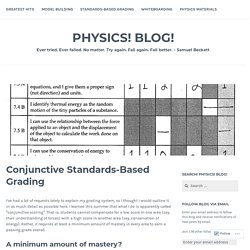
I learned this summer that what I do is apparently called “conjunctive scoring”. That is, students cannot compensate for a low score in one area (say, their understanding of forces) with a high score in another area (say, conservation of energy). Rather, it requires at least a minimum amount of mastery in every area to earn a passing grade overall. A minimum amount of mastery? My physics objectives are split into “A” and “B” flavors. Even if a student has shown mastery on some B’s, if they are missing an A objective, they are not yet in a position to earn a passing grade at the end of the term.
How I grade assessments: Yes/No and Feedback First, I work through every test, marking them up with comments, corrects, etc. NGSS Assessment Portal. Next Generation Science Assessment – Developing NGSS-aligned assessments and curricula for the next generation of K-12 students. Eliciting Evidence of Student Learning. <div class='noindex'>You may be trying to access this site from a secured browser on the server.
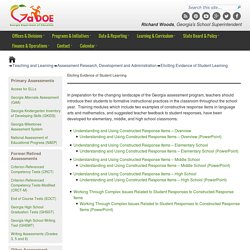
Please enable scripts and reload this page. </div> Skip Ribbon Commands Skip to main content. TIMSS & PIRLS — Methods and Procedures in TIMSS 2015. Welcome Teachers. WARNING: It appears you are using a browser that is known to have problems when using this site.
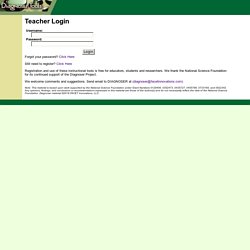
It is recommended that you upgrade your browser or use an alternative such as Chrome or Firefox. WARNING: It appears you are using Internet Explorer 8. Internet Explorer 8 is known to be very slow when using this site and it cannot run some of this sites features. It is recommended that you upgrade your browser or preferrably change to a different browser such as Chrome or Firefox. Forgot your password? Still need to register? Wisconsin Science and STEM Education: Creating NGSS-Aligned Performance Tasks – Part 1. Whether you’re at the end of the unit or want to check for understanding earlier, performance tasks provide a way to gauge students’ abilities to engage in scientific thinking and use their content knowledge.
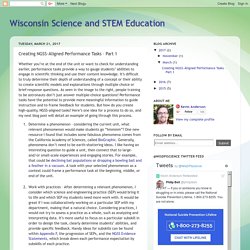
It’s difficult to truly determine their depth of understanding of a concept or their ability to create scientific models and explanations through multiple choice or brief-response questions. As seen in the image to the right, people training to be astronauts don’t just answer multiple-choice questions! Whydoscientists.
The Center on Standards & Assessment Implementation. The SAIC produced the following guiding documentation that will be used by the 15 participating states—and are available publicly—to inform large-scale NGSS test and item development: An Assessment Framework that includes the overall test design, description of an aligned test item cluster as the foundational unit of an NGSS-aligned assessment, specifications for various types of test items, and accessibility principles;Item Specifications Guidelines that detail a model of NGSS item cluster specifications, classify item types for consideration in an item cluster, identify key elements for each item cluster, and describe the linkage between item clusters and the NGSS;Two Item Cluster Prototypes (Grade 5 and High School) that can be used by the participating states to inform test item development.
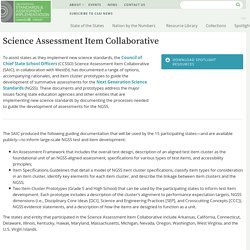
NGSS 3D Formative Assessment Task Design PD. Stanford NGSS Assessment Project. Next Generation Science Assessment – Developing NGSS-aligned assessments and curricula for the next generation of K-12 students. How can assessments be designed to engage students in the range of science and engineering practices? : StemTeachingTools. Classroom Sample Tasks. The Classroom Sample Tasks blend content, practices, and concepts from both the NGSS and the Common Core State Standards.
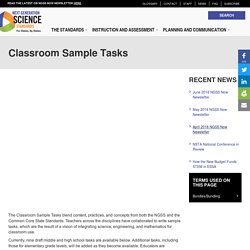
Teachers across the disciplines have collaborated to write sample tasks, which are the result of a vision of integrating science, engineering, and mathematics for classroom use. Currently, nine draft middle and high school tasks are available below. Additional tasks, including those for elementary grade levels, will be added as they become available. Science Assessment. Science 2 / Summative Assessment 9-12. Search: Use Advanced Search Citizen Services Get Park Passes Check Traffic Get Fishing License Unemployment Claim Pay Traffic Ticket Apply for Services Apply for State Job + More Business Services Incorporate Register a Business Name Availability Search Entity Names Search Trade Names Renew License Search Licenses.
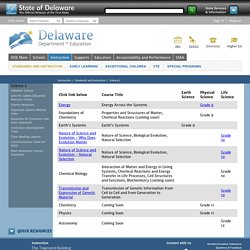
Stanford NGSS Assessment Project (SNAP) Stanford NGSS Assessment Project (SNAP) Untitled. Stanford NGSS Assessment Project (SNAP) Stanford NGSS Assessment Project (SNAP) Using mathematical and computational thinking. Stanford NGSS Assessment Project (SNAP) Stanford NGSS Assessment Project (SNAP) Stanford NGSS Assessment Project (SNAP) Stanford NGSS Assessment Project (SNAP)
Prototype Professional Development Modules. DBIR ⇢ Talks and Papers ⇢ NSTA 2016 Workshop "How to Assess Three-Dimensional Learning in Your Classroom: Building Tasks that Work" Below are materials from the workshop, "How to Assess Three-Dimensional Learning in Your Classroom: Building Tasks that Work" held at the National Science Teachers Association meeting in Nashville on April 2, 2016.

DBIR ⇢ Talks and Papers ⇢ NSTA 2016 Workshop "How to Assess Three-Dimensional Learning in Your Classroom: Building Tasks that Work" Contingent Pedagogies. DBIR ⇢ Talks and Papers ⇢ NSTA 2015 PDI Developing Next Generation Science Assessments. This bundle includes materials from the Professional Development Institute held at the National Science Teachers Association meeting in Chicago on March 11, 2015.
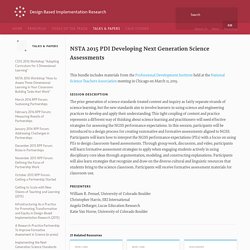
DBIR ⇢ Talks and Papers ⇢ NSTA 2016 Workshop "How to Assess Three-Dimensional Learning in Your Classroom: Building Tasks that Work" SHORT COURSE: How to Develop 3D Formative Assessments for the Science Classroom : StemTeachingTools. SHORT COURSE: How to Develop 3D Formative Assessments for the Science Classroom Posted on April 05, 2016.

Student Generated Models as a Pre-Assessment. With my Next Generation Science Standards (NGSS) goggles on this year, I decided to start my unit on Atomic Theory and Structure in my Chemistry classes by having the students build their own model of what they think an atom looks like. They worked in groups of two, and I just had a cart sitting out loaded up with various extraneous materials that I had available (cotton balls, aluminum foil, steel wool, straws, wire, tape, scissors, construction paper, balloons, fishing line, etc.). In addition to building the model, they had to write in their science notebooks “My model represents an atom because……” After students had finalized their models, each pair of students then presented their model to the class,explaining why/how their model represented an atom. This was just a sharing, no judging or talking about who did best. Some students wanted to know if they were right, but I wouldn’t say anything, just that we would be exploring atomic models the next day.
Here’s what I discovered: 1. Science Formative Assessment Tools and Resources. Here you will find a variety of tools and resources to use with the science formative assessment publications. Check back periodically as new tools and resources are added. Correlation Guides for the Uncovering Student Ideas in Science Probes and the Next Generation Science Standards: The NGSS are based on the disciplinary core ideas from the Framework for K-12 Science Education.
These correlation guides link the disciplinary core ideas from the Framework to the USI probes. These guides will be updated as new USI books are released. Assessment Tools. Below are links to assessment tools and techniques along with specific geoscience examples and resources. Carol Ormand's toolbox, complete with rock hammer. Photo courtesy of Carol Ormand. Concept Maps - A diagramming technique for assessing how well students see the "big picture". ConcepTests - Conceptual multiple-choice questions that are useful in large classes. Knowledge Survey - Students answer whether they could answer a survey of course content questions. Topics Of Particular Interest. Welcome to PALS. DC Science Assessment: An Assessment of the Next Generation Science Standards (NGSS) Last year, the Office of the State Superintendent of Education (OSSE) introduced the nation’s first statewide assessment of the Next Generation Science Standards (NGSS).
In 2013, the District of Columbia adopted the NGSS, which are based on the National Research Council’s Framework for K–12 Science Education, as its state learning standards. Each standard focuses on three foundational dimensions: disciplinary core ideas (DCI), cross cutting concepts (CCC), and science and engineering practices (SEP). The NGSS integrate content and application and reflect how science and engineering are practiced in the real world. The new DC Science Assessment uses scenarios and interrelated questions set in real-world contexts to increase student engagement and evaluate their performance in three-dimensional science learning. The spring 2016 operational test will continue to reflect the District’s transition to NGSS.
Testing Window: May 2 – June 3, 2016. The Center on Standards & Assessment Implementation. Plickers. Model Curriculum. Why a model curriculum? The purpose of providing a “model” is to assist districts and schools with implementation of the Common Core State Standards and New Jersey Core Curriculum Content Standards by providing an example from which to work and/or a product for implementation.
Each unit contains targeted student learning objectives (SLOs) that elucidate what students need to know and be able to do within the unit. The six-week formative assessments included in the model curriculum help clarify the level of rigor expected from the standards and provide a set of assessment tools that are often difficult for districts and schools to create on their own. What is the model curriculum? The model curriculum (version 1.0) includes all standards of the grade-level content organized into five units of study, each with targeted SLOs, intended for six weeks of instruction each. K12. PALS.